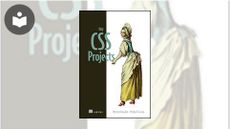Beginning CSS3
- 8h 12m
- David Powers
- Apress
- 2012
Beginning CSS3 teaches you how to style web pages using Cascading Style Sheets (CSS)—the language of web design. Starting from first principles, you’ll learn through a series of practical exercises how to change the default look of HTML tags, adding color, backgrounds, and borders. The book demystifies core concepts, such as the CSS box model and selectors, giving you the confidence and knowledge to create innovative and flexible page layouts. You’ll also learn how to create rounded corners, drop shadows, and gradients without the need for images, using the latest CSS3 techniques.
What you’ll learn
- Teaches how to style attractive and flexible web pages
- Hands-on exercises demonstrate how to combine style rules for different effects
- Comprehensive coverage of CSS2.1 and stable parts of CSS3
Who this book is for
Beginning CSS3 is aimed at web designers who want to master the use of Cascading Style Sheets to style and lay out modern web pages. It teaches core concepts, such as the CSS box model and choosing the most appropriate selectors to apply styles efficiently. This makes it an excellent choice for both complete beginners and web designers who want to improve their understanding of CSS.
About the Author
David Powers is an Adobe Community Expert for Dreamweaver and author of a series of highly successful books on PHP, including PHP Solutions: Dynamic Web Design Made Easy and Foundation PHP for Dreamweaver 8. As a professional writer, he has been involved in electronic media for more than 30 years, first with BBC radio and television and more recently with the Internet. His clear writing style is valued not only in the English-speaking world; several of his books have been translated into Spanish and Polish. What started as a mild interest in computing was transformed almost overnight into a passion, when David was posted to Japan in 1987 as BBC correspondent in Tokyo. With no corporate IT department just down the hallway, he was forced to learn how to fix everything himself. When not tinkering with the innards of his computer, he was reporting for BBC television and radio on the rise and collapse of the Japanese bubble economy. Since leaving the BBC to work independently, he has built up an online bilingual database of economic and political analysis for Japanese clients of an international consultancy.
In this Book
-
Introducing CSS—The Language of Web Design
-
Using Basic Selectors
-
Specifying Sizes, Colors, and Files
-
Styling Text
-
Embedding Web Fonts
-
Understanding the CSS Box Model
-
Floating Elements for Layout
-
Adding Backgrounds
-
Adding Borders and Drop Shadows
-
Styling Lists and Navigation Menus
-
Positioning Elements Precisely
-
Cross-Browser Layout Techniques
-
Using Advanced Selectors
-
Styling Tables
-
Generated Content
-
Creating a Print Style Sheet
-
Targeting Styles with Media Queries
-
Using CSS3 Multi-Column Layout
-
Creating Gradients Without Images
-
2D Transforms and Transitions
-
Animating with CSS Keyframes
-
What Next?



